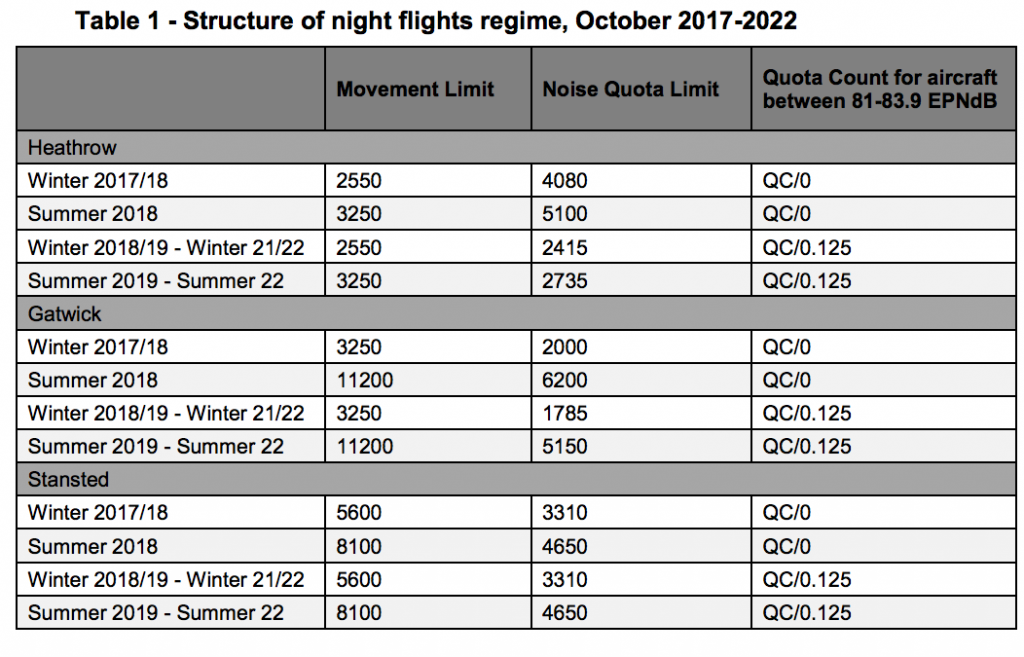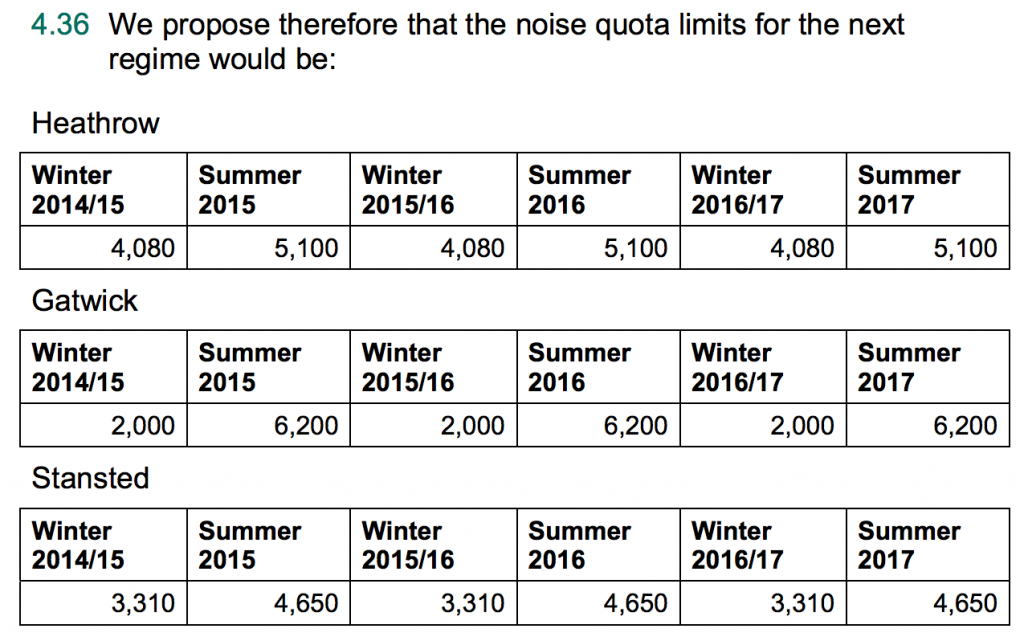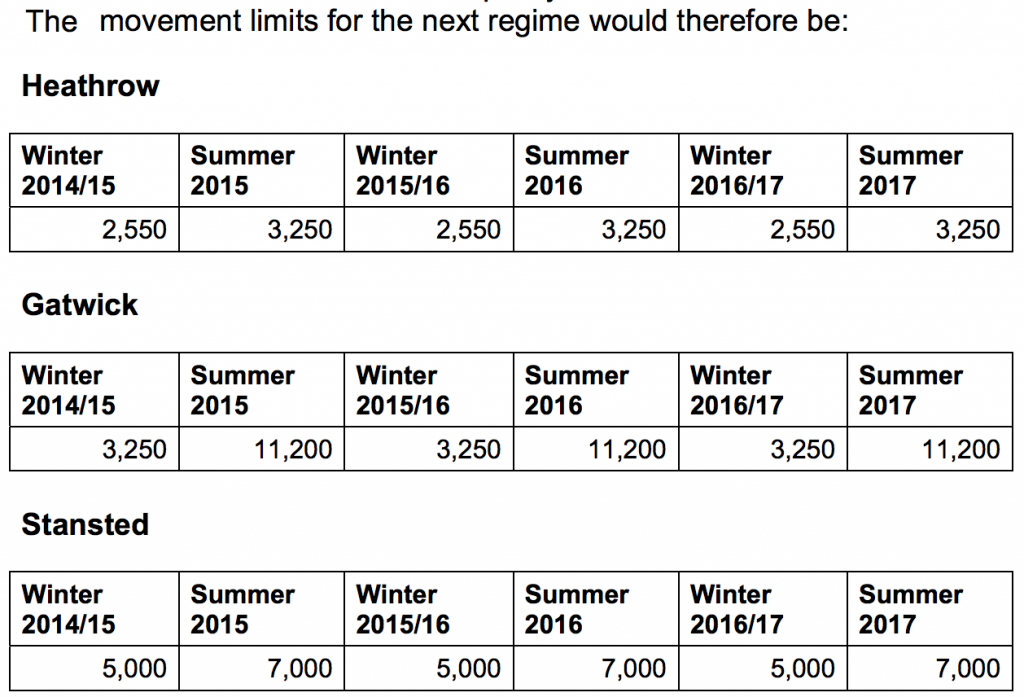DfT confirms numbers of night flights – till 2022 – at Heathrow, Gatwick and Stansted will not be cut
Changes to the night flights regime, at Heathrow, Gatwick and Stansted have been delayed for several years. The DfT has now produced its Decision Document on the issue. Anyone expecting meaningful cuts in night flights, or noise from night flights will be disappointed. There is no change in numbers, and just some tinkering with noise categories. The DfT says night flights from Heathrow will continue until (if) the airport is expanded, and it just hopes airlines will be using slightly less noisy planes. Pretty much, effectively, “business as usual.” Chris Grayling, Transport Secretary, said he had to “strike a balance between the economic benefits of flying and the impact on local residents.” The DfT objective is to: “encourage the use of quieter aircraft to limit or reduce the number of people significantly affected by aircraft noise at night, while maintaining the existing benefits of night flights”. But it says: “Many industry responses welcomed the recognition by government of the benefits night flights offer and highlighted the importance of night flights to the business models of airlines, for instance by allowing low-cost airlines to operate the necessary minimum amount of rotations a day, or the benefits to the time-sensitive freight sector through enabling next day deliveries. ”
.
Tweet
Heathrow night flights to continue until third runway is built
Transport secretary says new rules on noise show government is tackling issue, but campaigners lament ‘business as usual’
By Gwyn Topham and Jessica Elgot (Guardian)
Thursday 13 July 2017
.
Night flights from Heathrow will continue until the airport is expanded, the government has confirmed, as it published new rules to encourage quieter aircraft across London’s three biggest airports.
The transport secretary, Chris Grayling, said efforts to reduce the total noise permitted from flights at Heathrow, Gatwick and Stansted showed the government was taking the issue very seriously, but residents’ groups said the proposals were “business as usual”.
Grayling said that although he supported a six-and-a-half hour nightly window without flights once Heathrow’s third runway was built, he had to strike a balance between the economic benefits of flying and the impact on local residents.
He confirmed that a parliamentary vote on Heathrow expansion would not be held until at least 2018, rather than the winter of 2017-18, as previously stated.
The measures will ensure that all flights, including smaller and quieter planes, are counted within quotas on movements and lower overall noise limits. However, the rules reflect a trend towards much quieter, more modern planes and are unlikely to affect airlines’ operations significantly.
In a written statement to parliament, Grayling said caps had not kept pace with technology, but the new measures would “lock in the benefits”.
“I am fully aware that noise is a major concern for those living near these airports and that night noise is widely regarded as the most disturbing impact of aviation,” he said.
The five-year caps on noise come after a consultation launched in January on the night flight regime, with the government rejecting calls from campaigners for a clampdown on night noise. Grayling said: “This decision strikes a balance between managing the impacts on local communities by locking in the benefits offered by recent technological developments, with the economic benefits of night flights.”
Residents remained sceptical. John Stewart, the chair of campaigning group Hacan, said: “Today’s statement shows that the government recognises how important night flights are to local communities, but essentially they are proposing business as usual.”
Campaigners for communities around Gatwick said the government’s response was disappointing and warned that the quotas allowed for more night flights in winter than currently operated by the airport.
A spokesperson for Heathrow said the airport welcomed the government’s efforts, adding: “We know this is an issue that is particularly important to our local communities and we have already been working with our airlines to reduce the number of late-running flights.”
In the statement, Grayling acknowledged that the general election last month would lead to further delays on the parliamentary vote on expansion, which would now take place in the “first half of 2018”. The transport select committee will also need to restart its inquiry into the policy, which is unlikely to begin until after the parliamentary summer and conference recesses.
Theresa May’s loss of her majority is unlikely to significantly affect the chances of the vote passing through the House of Commons. Although the Labour leader, Jeremy Corbyn, and the shadow chancellor, John McDonnell, whose constituency borders the airport, are personally opposed to third runway expansion, a majority of the party’s MPs are in favour. Labour’s manifesto says it “recognises the need for additional airport capacity in the south-east”.
.
Night flights to continue at Heathrow despite protests from Richmond Council
14.7.2017
Night flight restrictions at Heathrow, Gatwick and Stansted
Decision Document
Moving Britain Ahead (by DfT)
DfT document at
https://www.gov.uk/government/uploads/system/uploads/attachment_data/file/627890/night-flight-restrictions-at-heathrow-gatwick-and-stansted-decision-document.pdf
Below is just the introduction:
Introduction
1. This government response follows the consultation launched on 12 January on
options to replace the existing night flight restrictions at Heathrow, Gatwick and
Stansted Airports, which expire in October 20171
.
2. In our consultation we proposed a five year regime, lasting until October 2022, which
would maintain the status quo in terms of movements while encouraging the use of
quieter aircraft at all three airports.
3. To achieve this we proposed to introduce changes to the quota count system to
ensure communities living around airports were protected from a potentially unlimited
number of aircraft that would otherwise be exempt from the restrictions. We also
proposed to adjust Stansted’s movement limits to reflect the fact that a large number
of these exempt aircraft are already operating there.
4. In order to incentivise the use of quieter aircraft at each airport we also proposed that
as a minimum noise quota limits at Heathrow and Gatwick should be reduced to
prevent the average amount of noise produced by an aircraft from becoming any
higher than is currently the case. At Stansted we proposed the noise quota limit
should not rise so that if the adjusted movement limit was to be fully utilised, the
average noise quota of an aircraft will have to reduce compared to the current level.
We also stated we would look to make further reductions to noise quotas if these
would be feasible and could be done without reducing the existing benefits of night
flights at these airports.
5. While we have amended some of our original proposals following consideration of
the numerous consultation responses that were received, we do not consider there to
be any new evidence or arguments put forward that would justify moving
fundamentally away from the approach proposed within our consultation.
6. Our final environmental objective for the next regime is therefore to ‘Limit or reduce
the number of people significantly affected by aircraft noise at night, including
through encouraging the use of quieter aircraft, while maintaining the existing
benefits of night flights’
7. Our achievement against this objective will be measured by:
The area of and number of people in the 48dB LAeq 6.5hr night contour
Sleep disturbance impacts associated with night flights, assessed using webTAG
methodologies. (2 – see note below)
The average noise on an aircraft (as measured by the average noise Quota Count
per aircraft movement over the course of a season).
[Note 2: As measured down to 45dbB LAeq 6.5hr using the Department for Transport’s webTAG methodology. It is not currently possible to robustly value health and annoyance impacts associated with night noise. WebTAG is regularly assessed to ensure the evidence base and methodologies are up to date. We will monitor this area to ensure any changes in webTAG are reflected in this indicator.]
Number of movements in the night quota period
.
8. The next night flights regime, which will last until October 2022, will maintain the
status quo in terms of movements. A new QC/0.125 category will be introduced to
capture the bulk of aircraft which are currently exempt, and any aircraft that are
quieter than this will also count towards an airport’s movement limits though they will
remain exempt from the noise quota limits. Stansted’s movement limits will be
adjusted to reflect these changes while the movement limits at Heathrow and
Gatwick will remain the same.
9. We will reduce noise quota limits at Heathrow and Gatwick to a value based on their
current usage, though the final limits differ slightly from those proposed within our
consultation due to adapting our methodology for calculating these as a result of
feedback received from consultation responses. These final limits represent
significant reductions in noise quota limits that will mean if an airport is to make
maximum use of its movement allowance then the average noise produced by an
aircraft cannot increase. This will further incentivise the use of quieter aircraft by
encouraging industry to plan its operations with sufficient headroom to ensure the
limits can still be complied with in the event of unplanned disruption or changes to
their schedules.
10. At Stansted, the current noise quota limits will remain in place. Coupled with the
adjustment to the airports movement limits, this will mean that the noise produced on
average by an aircraft will have to reduce compared to today’s level if the airport is to
fully utilise its new allowance. Overall, our changes at Stansted will benefit
communities by meaning fewer movements will be allowed to take place and less
noise will be able to be produced than if the existing rules remained in place.
11. In our consultation we proposed to consider options for further noise quota
reductions beyond these limits. However, we did not receive sufficient information
through our consultation that would allow us to set further reduced noise limits with
any certainty that they would be achievable and would allow the existing benefits of
night flights to be maintained.
12. Following feedback received through our consultation about the timing of our
proposals on night flights coming later than airlines would usually begin planning their
changes for the winter 2017/18 and summer 18 seasons by, we have decided to
defer some of these changes for the first year of the regime.
13. Therefore, from October 2017:
All aircraft movements will now count towards an airport’s movement limit. No
aircraft will be exempt from the movement limits but aircraft that currently fall
below the QC/0.25 threshold will remain QC/0 (i.e. exempt from the noise quota
limits).
Stansted’s movement limits will be adjusted to 5,600 in the winter and 8,100 in the
summer
.
14. Then, from October 2018:
A new QC/0.125 category will be introduced for aircraft from 81 to 83.9 EPNdB
Aircraft quieter than this will continue to count towards the airports’ movement
limits and remain QC/0
Noise quota limits at Heathrow will be reduced to 2415 in the winter and 2735 in
the summer and at Gatwick to 1785 in the winter and 5150 in the summer.
.
15. The rules for next regime are summarised in the table below.

….. and it goes on …..
.
By contrast, this is the document about the consultation on night flights in 2013.
https://www.gov.uk/government/uploads/system/uploads/attachment_data/file/256237/night-flying.pdf
they said then:

and

One of the questions in the DfT night flights consultation was about their “objective” to:
..”encourage the use of quieter aircraft to limit or reduce the number of people significantly affected by aircraft noise at night, while maintaining the existing benefits of night flights”.
The document then says this:
2.11 Industry were generally supportive of the objective but asked that in measuring it consideration was given to take account of new homes that are built within the relevant contours. Some airlines also felt the new objective penalised those who had already invested in quieter aircraft. Many industry responses welcomed the recognition by government of the benefits night flights offer and highlighted the importance of night flights to the business models of airlines, for instance by allowing low-cost airlines to operate the necessary minimum amount of rotations a day, or the benefits to the time-sensitive freight sector through enabling next day deliveries. There were some calls to consider other measurements to determine whether the element of the environmental objective relating to the benefits of night flights was being met.
….
People overflown will not be pleased to hear their sleep is to continue to be disrupted, in order that low cost airlines can fly very cheap flights, and some companies depend on next-day deliveries, to save the inconvenience of having to store products. [Mad, mad world. AW comment]
